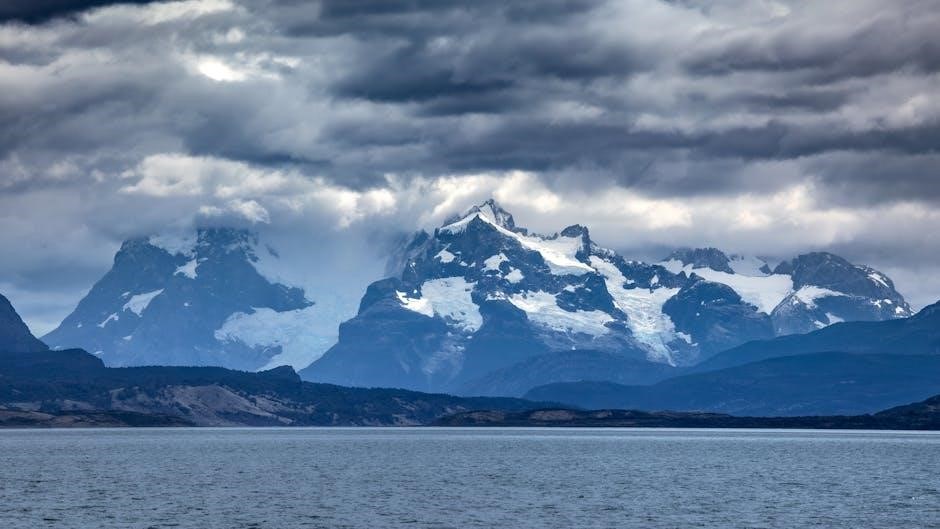
Properly washing your Patagonia Nano Puff Jacket requires care to maintain its insulation and water-repellent finish. Use cold water, mild detergent, and gentle cycles to preserve performance. Hand washing or low-heat tumble drying is recommended. Regular cleaning ensures longevity while maintaining the DWR finish for optimal functionality.
Understanding the Patagonia Nano Puff Jacket
The Patagonia Nano Puff Jacket is a lightweight, insulated piece designed for versatility in outdoor activities. It features recycled insulation, providing warmth without bulk, and a durable ripstop fabric for resistance to wind and abrasion. The jacket’s water-repellent DWR (durable water repellent) finish enhances performance in wet conditions. Proper washing is essential to maintain its insulation, fabric integrity, and water-repellent properties. Over-washing or using harsh detergents can degrade the insulation and DWR coating, reducing the jacket’s effectiveness. By following specific care guidelines, you can ensure the Nano Puff remains a reliable and high-performing piece in your outdoor gear collection. Regular maintenance also supports the jacket’s longevity and sustainability, aligning with Patagonia’s environmental values.
Importance of Proper Washing Techniques
Proper washing techniques are crucial for maintaining the performance and longevity of the Patagonia Nano Puff Jacket. Improper washing can damage the insulation, degrade the DWR finish, or harm the fabric, reducing its water-repellent and insulating properties. Using harsh detergents or high heat can strip the jacket of its protective coatings, leading to reduced functionality. Regular, gentle cleaning helps preserve the jacket’s loft, breathability, and water resistance, ensuring it remains a reliable outer layer for outdoor adventures. By following recommended care methods, you can extend the life of the jacket while maintaining its environmental performance and sustainability. Proper washing also aligns with Patagonia’s commitment to reducing waste and promoting gear longevity.

Key Considerations Before Washing
Always check the care label, choose between machine or hand washing, and select a mild detergent to prevent damage to the jacket’s insulation and fabric.
Checking the Care Label
Before washing, always examine the care label inside your Patagonia Nano Puff Jacket for specific instructions. It provides crucial guidance, such as recommended wash cycles, water temperature, and drying methods. Some jackets may require hand washing, while others can be machine washed on a gentle cycle. The label may also specify whether tumble drying is allowed or if air drying is preferred. Ignoring these instructions can lead to damage, such as insulation clumping or fabric deterioration. Patagonia often recommends using mild detergents and avoiding harsh chemicals to maintain the jacket’s water-repellent coating. Following the care label ensures your jacket remains in optimal condition for years to come.
Machine Washing vs. Hand Washing
Machine washing and hand washing are both viable options for cleaning the Patagonia Nano Puff Jacket, but each method has its advantages. Machine washing is faster and more convenient, provided you use a gentle cycle with cold water and a mild detergent. However, hand washing allows for a more meticulous cleaning process, which can be better for preserving the jacket’s insulation and fabric integrity. Before choosing, always check the care label for specific recommendations. If the label permits machine washing, use a delicate cycle to avoid damaging the fabric or insulation. For hand washing, submerge the jacket in cold water with a small amount of mild detergent, gently agitate, and rinse thoroughly. Both methods require careful attention to maintain the jacket’s performance and longevity.
Choosing the Right Detergent
Selecting the appropriate detergent is crucial for maintaining the Patagonia Nano Puff Jacket’s performance. Use a mild, non-toxic detergent that is specifically designed for technical or waterproof garments. Avoid harsh detergents, bleach, or fabric softeners, as these can damage the jacket’s insulation, fabric, or water-repellent coating. Opt for a detergent that is free of abrasives and optical brighteners, which can degrade the material over time. For best results, choose a detergent that is labeled as suitable for washing down-filled or synthetic insulated items. This ensures the jacket retains its loft, insulation properties, and DWR (durable water repellent) finish. Always follow the detergent manufacturer’s instructions for proper dosage to avoid over-saturating the fabric.

Step-by-Step Washing Guide
Check the care label, turn the jacket inside out, and use a gentle detergent. Wash in cold water on a delicate cycle or hand wash. Reshape while wet, then tumble dry on low heat or line dry. Avoid dry cleaning or ironing.
Preparing the Jacket for Washing
Before washing, turn the jacket inside out to protect the outer fabric. Close all zippers and fasteners to prevent abrasion. Empty pockets and remove any loose items. Inspect for stains and spot clean if necessary. Use a mild detergent designed for technical fabrics. Avoid fabric softeners or bleach, as they can damage the DWR finish. Gently brush off loose dirt from the exterior. If hand washing, fill a sink with cold water and mix in detergent. For machine washing, place the jacket in a mesh laundry bag. Reshape the jacket while it’s damp to maintain its original form. Avoid wringing or twisting, as this can stretch or damage the material.
Machine Washing Instructions
To machine wash your Patagonia Nano Puff Jacket, start by turning it inside out to protect the outer fabric. Use a front-loading washing machine without an agitator to minimize damage. Select a delicate or gentle cycle with cold water—below 30°C (86°F). Use a mild detergent, preferably one designed for technical or waterproof fabrics, and avoid fabric softeners or bleach. Place the jacket in a mesh laundry bag for added protection. After washing, remove excess water gently without wringing. For drying, tumble dry on a low heat setting or air dry. If using a dryer, add clean tennis balls to help fluff the jacket. Avoid high heat and long drying times to preserve the insulation and fabric integrity. Proper drying ensures the DWR finish remains effective and the jacket retains its loft and performance.
Hand Washing Instructions
To hand wash your Patagonia Nano Puff Jacket, start by filling a sink or large bucket with cold water. Add a mild detergent specifically designed for technical or waterproof fabrics, avoiding regular detergents, fabric softeners, or bleach. Submerge the jacket and gently agitate it to distribute the detergent evenly. Avoid scrubbing, as this could damage the fabric. Let it soak for about 15 minutes before rinsing thoroughly with cold water to remove all soap residue.
Gently squeeze out excess water without wringing. Reshape the jacket to its original dimensions and lay it flat on a clean towel to air dry. Avoid hanging or exposing it to direct sunlight or heat. Ensure it is completely dry before storing to prevent mildew. Using a mild detergent like Nikwax Tech Wash is recommended to maintain the jacket’s water-repellent qualities. Patience is key to preserving the jacket’s performance and extending its lifespan.

Drying and Reactivating DWR Finish
After washing, line dry or tumble dry on low heat to reactivate the DWR finish. For best results, use a waterproofing spray like Nikwax after washing.
Tumble Drying on Low Heat
Tumble drying the Patagonia Nano Puff Jacket on a low heat setting is a safe and effective method. Place the jacket in the dryer on the lowest heat setting to prevent damage to the insulation and fabric. Remove it while still slightly damp to air-dry, as excessive heat can degrade the DWR finish. Avoid using high heat, as it may compromise the jacket’s water-repellent properties. For optimal results, ensure the jacket is zipped and turned inside out before tumbling. If desired, reactivate the DWR finish by running a low-heat cycle or using a specialized water-repellent treatment. Always check the care label for specific recommendations, and avoid over-drying to maintain the jacket’s loft and performance. Line drying is also recommended for preserving the jacket’s quality and extending its lifespan.
Line Drying for Optimal Results
Line drying is a recommended method for preserving the quality and longevity of your Patagonia Nano Puff Jacket. After washing, gently remove excess water without wringing the fabric. Hang the jacket in a well-ventilated area, away from direct sunlight, to prevent fading. Ensure the jacket is zipped and evenly spread to maintain its shape. Line drying avoids the risks of shrinkage and damage caused by high heat from tumble drying. This method also helps retain the jacket’s loft and water-repellent finish. Allow it to air dry completely, which may take several hours, depending on humidity. Proper line drying ensures the jacket remains in excellent condition for future use.
Reactivating the Water-Repellent Coating
Over time, the water-repellent finish on your Patagonia Nano Puff Jacket may wear off, reducing its performance. Reactivating the DWR (Durable Water Repellent) coating is essential to restore water resistance. After washing, tumble dry the jacket on a low heat setting to help rejuvenate the finish. If the DWR is severely degraded, apply a DWR treatment specifically designed for waterproof and breathable fabrics. Follow the product instructions for proper application; Regular reactivation ensures the jacket maintains its water-repellent properties and continues to perform as intended. This simple step can extend the life of your gear and keep it functioning optimally in wet conditions.
Special Care for Specific Materials
Patagonia Nano Puff Jackets may include recycled insulation and ripstop fabric, requiring gentle cleaning to preserve their integrity. Use mild detergents and avoid harsh chemicals to protect these materials.
Caring for Recycled Insulation
When washing the Patagonia Nano Puff Jacket with recycled insulation, use cold water and a mild detergent to prevent damage. Avoid harsh chemicals or bleach, as they can degrade the insulation. Gently cycle or hand wash to maintain loft and performance. After washing, reshape the jacket while damp to ensure the insulation remains evenly distributed. Do not wring or twist, as this can disrupt the recycled insulation. Tumble dry on low heat or air dry, but avoid direct sunlight, which may cause the insulation to break down. Proper care ensures the recycled insulation retains its warmth and functionality for years to come.
Maintaining the Ripstop Fabric
To maintain the Patagonia Nano Puff Jacket’s ripstop fabric, use a mild detergent and cold water to prevent weakening the material. Avoid harsh chemicals or bleach, as they can damage the fabric’s integrity. Gently wash by hand or use a delicate machine cycle to minimize abrasion. After washing, reshape the jacket while damp to restore its natural form. Tumble dry on low heat or air dry, as high heat can degrade the ripstop weave. Avoid using fabric softeners, as they may reduce the fabric’s breathability. Regularly cleaning and properly drying the jacket will help preserve the ripstop fabric’s strength and prevent tears, ensuring long-term durability and performance.

Common Mistakes to Avoid
Using harsh detergents, high heat, or fabric softeners can damage the Nano Puff’s insulation and DWR finish. Avoid soaking or scrubbing aggressively to prevent fabric degradation.
Using Harsh Detergents
Using harsh detergents or bleach can strip the Nano Puff Jacket of its water-repellent coating and damage the recycled insulation. Avoid abrasive cleaners, as they can degrade the ripstop fabric and harm the DWR finish. Instead, opt for mild, non-toxic detergents specifically designed for technical or waterproof gear. These gentle cleansers effectively remove dirt without compromising the jacket’s performance. Fabric softeners should also be avoided, as they can leave residues that reduce breathability and water resistance. Always prioritize gentle cleaning products to maintain the jacket’s insulation, fabric integrity, and water-repellent properties. This ensures the Nano Puff remains durable and functional for years to come.
Exposing to High Heat
Exposing your Patagonia Nano Puff Jacket to high heat can damage its materials and performance. High heat from washing or drying can break down the recycled insulation, reducing its loft and warmth. Additionally, excessive heat can damage the DWR (durable water repellent) finish, causing it to lose its water-repellent properties. The ripstop fabric may also shrink or become brittle when exposed to high temperatures. To prevent this, avoid washing the jacket in hot water and refrain from using high-heat settings in the dryer. Instead, opt for cold-water washing and low-heat tumble drying or air drying. This helps preserve the jacket’s insulation, fabric integrity, and water-repellent coating, ensuring it remains functional and durable for outdoor use.
Proper care ensures your Patagonia Nano Puff Jacket lasts longer, maintaining its insulation and water-repellent performance. Follow guidelines to preserve its quality and functionality for outdoor adventures.
Final Tips for Longevity
To ensure your Patagonia Nano Puff Jacket lasts, store it in a cool, dry place, avoiding prolonged folding. Spot clean stains to prevent excessive washing, which can degrade materials. Check for repairs before washing to prevent further damage. Reactivate the DWR finish as needed, possibly using reproofer products. Follow Patagonia’s care guidelines for optimal maintenance. These practices will help extend the jacket’s life and performance;
Patagonia’s Repair and Warranty Program
Patagonia offers a comprehensive repair and warranty program to extend the life of your Nano Puff Jacket. Their Worn Wear initiative encourages customers to repair their gear rather than replace it, promoting sustainability. If your jacket is damaged, Patagonia provides repair services or DIY guides to help you fix it. The program includes a lifetime warranty for defects in materials and workmanship, ensuring your jacket performs as intended. By utilizing these resources, you can maintain your gear’s quality and reduce environmental impact. Patagonia’s commitment to repair and sustainability aligns with their mission to create durable, long-lasting products.
 lego snowman instructions
lego snowman instructions  weber spirit 2 assembly instructions
weber spirit 2 assembly instructions  dtf care instructions
dtf care instructions  honda radio / navigation code retrieval and reset instructions
honda radio / navigation code retrieval and reset instructions  rough country installation instructions
rough country installation instructions  instructions for using
instructions for using  recovering from emotionally immature parents pdf
recovering from emotionally immature parents pdf